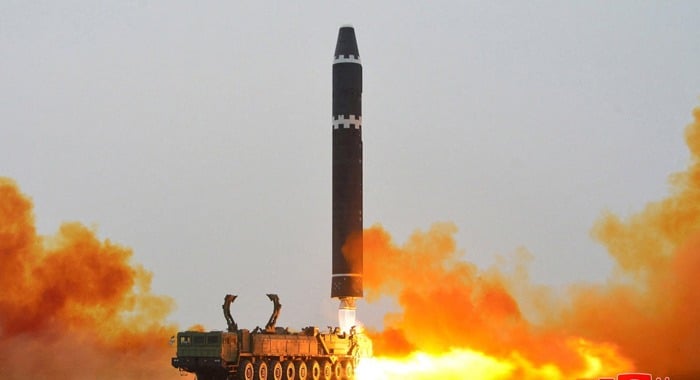As geopolitical fault lines harden and nuclear rhetoric resurges across continents, global security analysts are raising alarm over the imminent collapse of the world’s arms control architecture, warning that a single act of provocation such as a renewed nuclear test could trigger an uncontrollable domino effect.
Concerns have been mounting ever since former U.S. President Donald Trump signaled a potential return to nuclear explosive testing, should he reclaim the White House. Though such a move would break a decades-long global moratorium, some U.S. think tanks, including the Heritage Foundation, have argued that it might be necessary to reassert strategic dominance. But nonproliferation experts caution that any such decision could shatter fragile global restraint, spark a new arms race, and irrevocably damage international peace efforts.
“The threat is no longer theoretical,” one analyst warned. “We are closer than we’ve been in decades to the normalization of nuclear brinkmanship.”
From the radioactive ruins of Bikini Atoll in the Pacific to the frozen treaties of the Cold War era, the historical memory of nuclear testing remains etched into global consciousness. But the present danger is no longer in the past. The world now faces a highly complex and multipolar threat matrix where old treaties are crumbling, deterrence doctrines are fraying, and new alliances are forming among nuclear aspirants and adversaries.
A Global Chain Reaction
In East Asia, China is aggressively modernizing its nuclear arsenal while deepening ties with a defiant North Korea. These moves have rattled Japan and South Korea both technologically capable of developing nuclear weapons. Long dependent on U.S. security assurances, both countries are now engaged in quiet but serious internal debates about nuclear self-reliance.
South Asia remains locked in a volatile nuclear rivalry between India and Pakistan, reignited by territorial tensions in Kashmir. In the Middle East, Iran’s nuclear advances bolstered by weakened international oversight continue to provoke alarm. Even in Europe, Poland is now considering the acquisition of nuclear weapons. Prime Minister Donald Tusk recently declared that Warsaw would not remain defenceless in a world where “others are racing ahead.”
“The message is clear,” said one European strategist. “Without a credible international framework, nations will pursue their own deterrents—and the world will pay the price.”
The Collapse of Restraint
At the heart of the crisis lies the erosion of global arms control agreements. The landmark Treaty on the Non-Proliferation of Nuclear Weapons (NPT) is under unprecedented strain. The U.S. withdrawal from the INF Treaty and the Iran nuclear deal during Trump’s tenure dealt significant blows to the credibility of multilateral disarmament efforts. Now, with the New START Treaty between the U.S. and Russia set to expire in 2026, the world faces the prospect of unregulated superpower arsenals for the first time in decades.
Even the Comprehensive Nuclear Test-Ban Treaty (CTBT), once hailed as a cornerstone of nonproliferation, remains unenforced and increasingly sidelined.
“The arms control regime built over 50 years is disintegrating,” said a senior arms control official. “We are entering a world where nuclear doctrines are blurred, treaties are ignored, and new technologies are outpacing regulation.”
A Call for a New Global Framework
In response to the growing instability, arms control advocates are calling for a comprehensive reinvention of the global disarmament system one that is inclusive, adaptive, and forward-looking.
Among the proposed pillars of a new regime:
A universal No First Use doctrine;
A strict prohibition on the use of nuclear weapons against non-nuclear states;
AI-governance protocols for nuclear command and control systems;
A revised Outer Space Treaty to prevent the weaponization of space;
Enhanced transparency and regulation of dual-use and emerging technologies.
Some signs of diplomatic engagement offer cautious hope. China has floated interest in a multilateral No First Use pact, and Iran has expressed openness to rejoining talks under new terms. Experts suggest that a P5 Nuclear Summit involving the five permanent members of the UN Security Council could serve as a starting point for a modern arms control dialogue.
“Arms control cannot be frozen in Cold War logic,” said a defense policy expert. “We need a regime that reflects today’s threats cyber warfare, AI, hypersonics, and the militarization of space.”
The economic stakes are also significant. A recent study by the Georgetown Security Studies Review estimated that a single nuclear detonation in space—whether accidental or deliberate—could cost the global economy up to $3 trillion.
Time for Leadership
Analysts say the burden of leadership lies with the United States. By championing a new global arms control initiative, Washington could reassert its moral and strategic authority, stem proliferation risks, and prevent escalation into open conflict.
“The world is at a tipping point,” concluded one strategist. “We can either rebuild the scaffolding of peace or sleepwalk into a catastrophe.”
As tensions mount from Warsaw to Pyongyang and Tehran to Tokyo, the message from experts is clear: the clock is ticking. Unless urgent action is taken, the next nuclear crisis may not be hypothetical it may be real.





